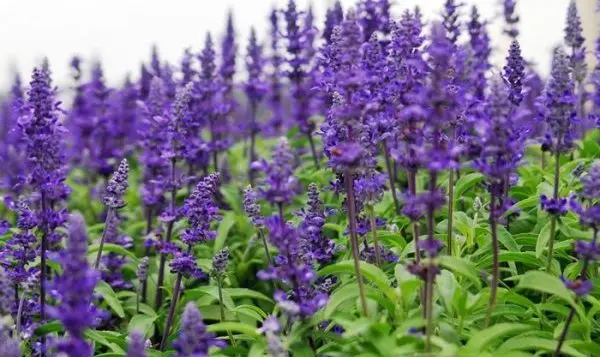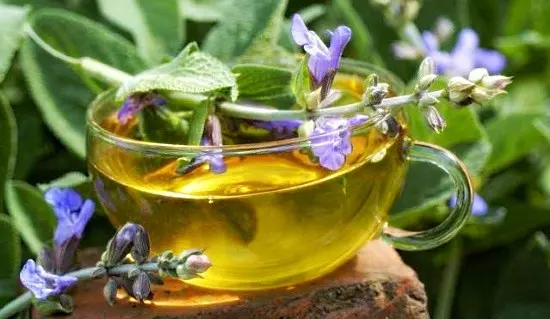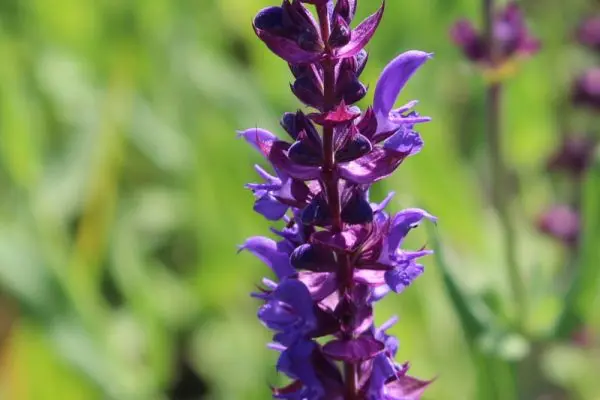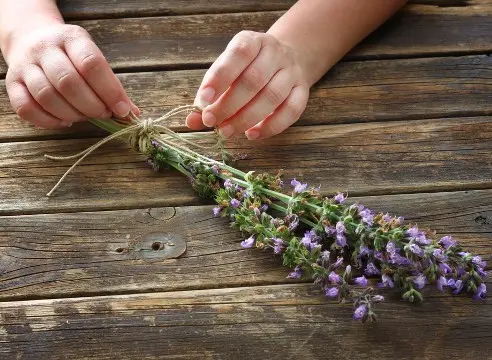Contents


Sage is widely used in cooking and is of particular value to medicine. A huge amount of useful components is concentrated in the leaves of the plant: flavonoids, phytoncides, alkaloids, resins, tannins and camphor substances, vitamins, but the plant is especially valuable with essential oil containing many active compounds, and thanks to which a strong aroma comes from the herb. In cultivated sage, the content of nutrients and esters changes during the growing season, so the plant is harvested for harvesting only in a certain period.
How to collect sage
Sage is a perennial herb with a full growing season of two years. Therefore, a full-fledged harvest of sage begins from the second year of the plant’s life. In the year of sowing the crop, the first harvest can be harvested only in the fall. In all subsequent years, grass is harvested in two stages: in summer (late June – July) and autumn (September – early October).

For medical purposes, leaves and tops of shoots are used, since it is in these parts of the plant that the maximum amount of nutrients and esters is concentrated. In the first two years, only the lower leaves are harvested from the bush, and in the future, the procurement of raw materials is carried out from the entire ground part. At the same time, you can collect leaves both with your hands and with the help of scissors, secateurs, a sickle – sage grows quickly, and cut off at the base in summer, it again forms a young bush by autumn.
It is advisable to collect sage on warm sunny days when the plant is dry. Dirty, dusty grass should first be washed with water from a watering can or hose, and then wait for the plants to dry completely. When collecting raw materials for a medicine, you need to make sure that diseased or insect-damaged shoots do not get into the total mass.
Video “What every gardener needs to know”
Demonstrative video with useful information for gardeners.
In summer time
Summer harvest of sage is carried out in early summer (end of June), when the inflorescences begin to bloom. The herb harvested during this period is more saturated with ethers, and therefore is of particular value for traditional medicine, as well as for cooking – dry plants are considered a spice and are successfully used as an additive to many dishes.

For drying, you should choose intact shoots with dark green foliage, as well as buds that have not fully blossomed. Summer harvesting of grass lasts approximately 20 days, until mid-July. Then the sage fades, and seeds begin to ripen in place of the inflorescences. During this period, the green part of the plant coarsens, and the concentration of useful components decreases, so it is not advisable to collect grass. The culture reproduces well by self-sowing – dry seeds that have fallen into the soil germinate after the first rain.
Collection in autumn
The second harvest of sage grass lasts from late September to mid-October, when the plants are fully restored after a hot summer. By autumn, self-sowing bushes will form and grow stronger, and velvety greens will grow back on bushes cut in summer, and buds will appear. The concentration of nutrients in the autumn grass is in no way inferior to that collected in the summer, so the autumn harvest is no less valuable.

In autumn, sage is also harvested on dry days. If the weather is more rainy, you need to wait until the plants are completely dry, and only then collect. Bushes growing within the city, especially along roads, should not be used for drying – such plants are saturated with industrial emissions and exhaust gases. For use in food and as a medicine, it is important that the herb is of high quality and properly collected.
How to store sage
Drying is necessary for long-term storage of sage. Properly harvested and well-dried grass can be stored for up to 2 years under the following conditions:
- a container for storing dry leaves must be breathable (made from natural materials: cardboard, parchment, cotton) – storage in tightly closed glass or metal jars is allowed, but not more than a year;
- the place or room for storing harvested grass should be dry, well ventilated and preferably dark;

- you should not store dried sage in bunches, as the grass quickly burns out and loses its useful and taste qualities – it is better to separate the leaves and inflorescences from the dried shoots, and then place them in containers intended for storage;
- it is necessary to regularly check the quality of dry raw materials, since very often various pests start up in the grass: food moth, mold;
- it is better to store dry raw materials separately from other herbs and products, because the strong sage aroma tends to quickly evaporate, mix and be absorbed.
It should also be borne in mind that in bags, boxes, bags, raw materials are stored longer, but at the same time its aroma disappears, and in tightly closed containers, the aroma lasts longer, but the shelf life of the herb is reduced due to the lack of ventilation.

Drying
Only intact leaves and tops of sage shoots are suitable for drying – the lower stems, as a rule, are very coarse, almost woody, so we do not harvest them for future use. Drying sage leaves is carried out in several ways:
- leaves and young shoots are torn off the stems by hand and placed on a covered metal surface, such as a baking sheet, covered with gauze or linen in one layer, and placed in a dry, well-ventilated place;
- an easier way is to dry the grass without breaking off the leaves – cut plants should be laid out on paper with a layer of 30-40 cm under a canopy in warmth, and after drying, thresh the inflorescences and leaves;
- drying grass in bunches is also popular – for this method, plants are tied, hung with inflorescences down, and after drying, dry foliage is separated from the stems;
- artificial drying is the fastest and most effective way, as it allows you to save more healing essential oils – when using a dryer, you need to make sure that the temperature in it does not rise above 35 ° C, since when overheated, the healing and essential properties of the herb disappear.

Natural drying of sage leaves is carried out only in the open air, under sheds, where moisture does not get. Dry grass is very fragrant, but if it is not properly dried, it can acquire a musty, unpleasant odor. To prevent this from happening, we constantly monitor the temperature and humidity of the air when harvesting plants – the temperature regime should be at the level of 30-35 ° C, and the humidity should not exceed 13%.
Video “Useful properties of sage”
Informative video about the benefits and properties of sage.
Author: Svetlana Galitsina
Loading…









